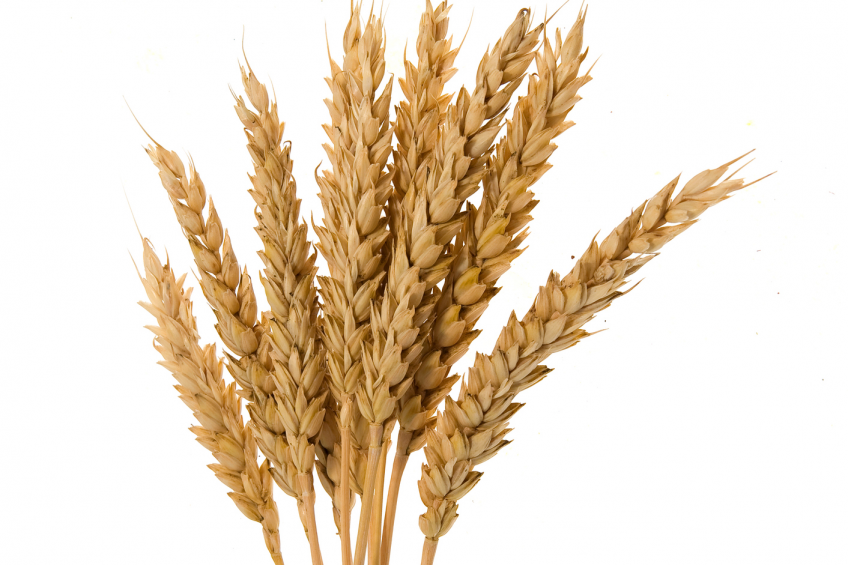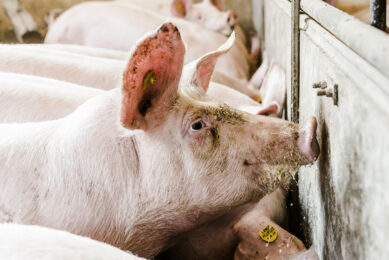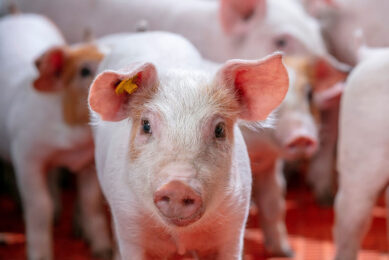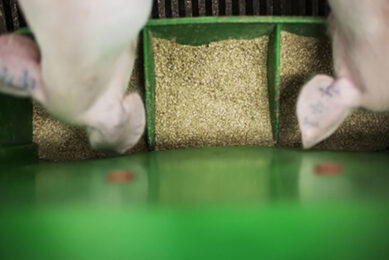Fibre’s role in animal nutrition and intestinal health

Dietary fibre has an important role in the complex interaction between the diet, the endogenous enzymes, the mucosa and the commensal microflora – all of which are considered important in the assimilation of nutrients and a key component for optimal intestinal health.
Dietary fibre (DF) is an important component of all but a few plant based feedstuffs used in the feeding of pigs. It is resistant to digestion by endogenous enzymes in the small intestine, thereby providing bulk to the gut lumen and becoming the main substrate for bacterial fermentation, particularly in the large intestine. Because of the physicochemical properties of DF it interacts both with the microflora and the mucosa of all sites of the gastrointestinal tract.
DF, by recent definition, now include non-starch polysaccharides (NSP), resistant starch (RS), non-digestible oligosaccharides (NDO) and the non-carbohydrate polyphenolic ether lignin. The main polysaccharides of NSP are cellulose, and a wide variety of non-cellulosic polysaccharides (NCP); β-glucan, arabinoxylan, xylans, xyloglucans and pectic substances to mention the major ones. The DF content of the feedstuffs varies widely with cereals generally having a lower concentration than legumes and protein rich crops, and generally there is a higher concentration of DF in co-products from cereals and the agro and food industries (Figure 1).
Figure 1 – Dietary fibre concentration (g/kg dry matter) in different feedstuffs.

There is also a wide variation in the composition of the NCP among feedstuffs; in cereals, arabinoxylan and β-glucan are high and β-glucan is responsible for the relatively high level of soluble NCP in barley and oats as compared to wheat and corn. In legumes, protein crops and fibre rich materials, pectins and xyloglucans are the main NCP’s and the pectins are responsible for the relatively high levels of soluble NCP in these feedstuffs. The concentration of RS is higher in legumes (peas and fava beans) than in cereals. Legumes, in general, also have the highest concentration of NDO’s among the feedstuffs. So, there are many possibilities in composing diets with different DF compositions.
A common feature of all DF sources is the ability to swell, hold water in the cell wall matrix, and to increase viscosity when exposed to water (Figure 2). However, while all DF sources swell and hold water, the viscous properties depend on the type and chemical nature of the polysaccharides making up the DF fraction. For instance, sugar beet pulp will primarily increase the water binding capacity of digesta, whereas the viscosity elevating properties of sugar beet pulp is low. Contrary to that, β-glucan will to a larger extent solubilise from the cell wall matrix and raise luminal viscosity.
Figure 2 – The hydration properties are characterised by the swelling capacity, solubility, and water binding capacity (WBC). The first part of the solubilisation process of polymers is swelling in which incoming water spreads the macromolecules until they are fully extended and dispersed. Themajority of polysaccharides give viscous solutions if dissolved in water. The viscosity is dependent on the chemical structure, the molecular weight of the polymer, and concentration.

Influence on the digestion and fermentation processes
The gastrointestinal tract consists of different compartments – mouth, stomach, small intestine and large intestine – and supplying organs – liver, pancreas – involved in the digestion and absorption processes. The whole assembly is integrated with the peripheral organs through a large set of receptors (distension, tactile, chemo) that monitor the digestive and absorptive processes through neural and hormonal feedback signals. In this way, variations in blood nutrient content are minimised and the provision of nutrients to the different organs are regulated and optimised. DF is the foremost important dietary factor influencing the digestion and absorption processes thereby regulating the provision of nutrients to organs and tissues not in direct proximity to the gastrointestinal tract.
DF influences the digestion and absorption processes at all sites of the gastrointestinal tract as well as the secretion of fluids from the pancreas and liver (Figure 3). Raised DF increases the weight and content of the gastrointestinal tract and leads to a higher flow of nutrients at all sites. Soluble DF will raise luminal viscosity thereby prolonging gastric emptying and interfering with the digestion processes in the small intestine by hindering the contact between the substrate and digestive enzymes and by slowing down the movements of hydrolytic products of the digestion processes. Soluble as well as insoluble DF will provide substrate for fermentation by the microflora in the large intestine. Soluble DF is readily fermentable; the major part is broken down in the caecum and proximal colon while insoluble DF is degraded at more distal locations and parts of it will not be broken down at all.
Figure 3 – Influence of dietary fibre on the physiological processes related to transit time, digestion and absorption processes in the various segments of the gastrointestinal tract and bulk and energy utilisation.

The main metabolites formed in consequence of microbial fermentation are short-chain fatty acids (SCFA; predominantly acetate, propionate and butyrate), which also lower the pH of the luminal content. The major part of the produced SCFA, however, is rapidly absorbed and provides energy to the host although the utilisation of the energy provided as SCFA is lower than that of the energy absorbed as, for instance glucose, from the small intestine. The reason for the lower energy
utilisation of SCFA compared to glucose, should be found in the loss of fermentation gasses and a lower utilisation of SCFA in the intermediate metabolism. Therefore, high DF diets have in general a lower energy content than low DF diets, primarily due to a lower digestibility but also due to a lower utilisation of absorbed energy.
Intestinal health effects
A prebiotic is a non-digestible food ingredient that affects the host beneficially by selectively stimulating the growth and/or activity of one or a limited number of bacteria in the colon, and thus improves host health. Of the Firmicutes and Bacteroidetes phyla present in most animal species, Enterobacteria spp., such as Escherichia coli, are considered negative for gut health as they are often associated with intestinal disorders, whereas Lactobacillus spp., Bifidobacterium spp., and Roseburia spp. are generally considered positive due to their health-promoting properties.
While DF in general increases the flow of carbohydrates to the large intestine, thereby stimulating the activity of the entire microbial population and thereby lowering pH, there are only few DF polysaccharides that have the ability specifically to stimulate beneficial microbial groups. Homo oligo- and polysaccharides are generally more efficient in modulating the microbial composition and a shift in the composition of the bacterial populations has been found when feeding inulin of variable chain lengths, fructans (a mix of oligo- and polysaccharides of fructose) and RS.
Arabinoxylan, the main DF component of rye and wheat, have also been found to influence the microbial composition by stimulating the proliferation of butyrate producing microorganisms and the production of butyrate. Butyrate is an important metabolite for the epithelial cells, providing energy and has a regulatory function for cell proliferation and differentiation. In this context it is of interest that the use of xylanase has been shown to degrade part of the arabinoxylan to a mix of oligomers at the end of the small intestine. Potentially, this can represent a not yet fully explored potential to modulate the microbial composition and metabolism in the large intestine.











